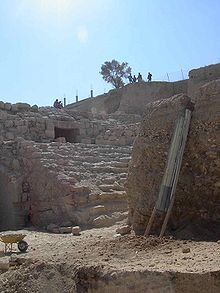Historical desertification
The current discussion about desertification often refers to changes in the settlement density in the desert belts since the emergence of the first advanced civilizations . It is assumed that humans have intervened heavily in the natural balance since the invention of arable farming and that desertification occurred again and again, i.e. irreversible degradation of the potential for use.
The Mediterranean region in particular and its transition zones to the Arab and North African deserts are characterized by many well-preserved ruins from the Roman - Byzantine period, which raised the question of why these once densely populated areas fell into desolation. It was assumed that population growth or the Muslim conquest led to overexploitation , which resulted in an irreversible degradation of agricultural potential through soil erosion . Soil erosion and reduced vegetation can lead to reduced rainfall through negative feedback.
However, development aid projects aimed at preventing further erosion did not achieve their goals, e.g. For example, such a project was carried out during the 1980s in the Zarqa Valley near the city of Jerash in Jordan, where the aim was to reduce the sediment input into the King Talal Dam and stabilize the soil through afforestation and the construction of terraces and rock pigs . However, a severe storm in the winter of 1991/92 led to dramatic sediment inputs into the dam, which made the expensive stone newts seem useless. In addition, no positive effect of the forest could be determined. On the contrary, reforestation with pines created new problems, as there is a very high risk of forest fires , the natural regeneration of the forest is partially lacking and the grazing pressure is being pushed into ecologically more sensitive areas such as the desert fringes. The evergreen trees also reduce the formation of new groundwater , so that in Greece the groundwater level was already falling due to the pine forest. A similar picture emerges in Germany, where pine afforestation in the area of the open pit counteracts the filling of the remaining open pit holes.
Studies in Jordan found that the erosion of the Terra Rossa occurred mainly at the end of the last ice age and during the younger dryas . This study assumes that the plateaus, which are used intensively for agriculture today, have not had any significant erosion processes since historical times. It can therefore be assumed that the current agricultural potential does not differ from the historical one and that soil degradation cannot have been the cause of the decline.
The discussion about the effects of climate change and desertification focuses on the importance of drought . While some authors argue that phases of decline in the Levant were largely in sync with reduced rainfall, others point out that settlement history was not consistent. However, a one-sided view of the rainfall is only limited statements about the profitability of agriculture and climatically induced environmental changes provide. Soils and colluvia provide important clues here: the recently discovered sediments in the theater of Beit Ras in the Decapolis in Jordan indicate that an accumulation of heavy rain events with very high surface runoff occurred during the late Byzantine-early Islamic period. As far as such events could be observed today, the damage caused was always enormous and could have far more serious consequences if they were to accumulate than a drought.
literature
- Beaumont, P .: Man-induced erosion in northern Jordan. In: Studies in the History and Archeology of Jordan 2 . Amman 1985, p. 421-431 .
- Cordova, C., Foley, C., Nowell, A., Bisson, M .: Landforms, sediments, soil development and prehistoric site settings in the Madaba-Dhiban Plateau, Jordan . In: Geoarchaeology . tape 20 , no. 1 , 2005, p. 29-56 .
- Dracup, J .: Climatic Change, Hydrology, and Water Management in Arid Lands . In: Wurtele & Berkofsky (Ed.): Progress in Desert Research . 1987, p. 217-228 .
- Dregne, H .: Desertification of Arid Lands . London 1983.
- Grove, A., Rackham, O .: The Nature of Mediterranean Europe: an Ecological History . New Haven 2003.
- Hazan, N., Stein, M., Agnon, A., Marco, S., Nadel, D., Negendank, J., Schwab, M., Neev, D .: The late Quaternary limnological history of Lake Kinneret (Sea of Galilee), Israel . In: Quaternary Research . tape 63 , 2005, pp. 60-77 .
- Lowdermilk, W .: Palestine - land of promise . London 1944.
- Lucke, B .: Demise of the Decapolis. Past and Present Desertification in the Context of Soil Development, Land Use, and Climate . Published online at OPUS, Cottbus 2007, urn : nbn: de: kobv: co1-opus-3431 .
- Migowski, C., Stein, M., Prasad, S., Negendank, J., Agnon, A .: Holocene climate variability and cultural evolution in the Near East from the Dead Sea sedimentary record . In: Quaternary Research . tape 66 , no. 3 , 2006, p. 421-431 .
- Müller, J., Bolte, A., Beck, W., Anders, S .: Ground vegetation and water balance of pine forest ecosystems (Pinus sylvestris L.) . In: Negotiations of the Society for Ecology . tape 28 , no. 3 , 1998, p. 407-414 .
- Rosen, A .: Civilizing Climate. Social Responses to Climate Change in the Ancient Near East. New York 2007.
- Schmidt, M., Lucke, B., Bäumler, R., al-Saad, Z., al-Qudah, B., Hutcheon, A .: The Decapolis region (Northern Jordan) as historical example of desertification? Evidence from soil development and distribution. In: Quaternary International . tape 151 , 2006, pp. 74-86 .
Individual evidence
- ↑ Past and present desertification in the context of climate change - a case study from Jordan ( Memento of the original from November 29, 2014 in the Internet Archive ) Info: The archive link was inserted automatically and has not yet been checked. Please check the original and archive link according to the instructions and then remove this notice. (PDF)
